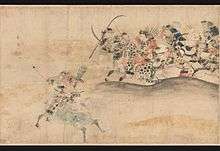Gosannen War
The Gosannen War (後三年合戦, gosannen kassen), also known as the Later Three-Year War, was fought in the late 1080s in Japan's Mutsu Province on the island of Honshū.[1]
| Gosannen War | |||||||
|---|---|---|---|---|---|---|---|
| Part of Clan disputes of the Heian period | |||||||
 | |||||||
| |||||||
| Belligerents | |||||||
| forces of various branches of Kiyohara clan | forces of Minamoto no Yoshiie, Governor of Mutsu province | ||||||
| Commanders and leaders | |||||||
| Kiyohara no Iehira, Kiyohara no Takahira, others | Minamoto no Yoshiie, Fujiwara no Kiyohira | ||||||
History
The Gosannen War was part of a long struggle for power within the warrior clans of the time.
The Gosannen kassen arose because of a series of quarrels within the Kiyohara clan (sometimes referred to as "Kiyowara"). The long-standing disturbances were intractable. When Minamoto no Yoshiie, who became Governor of Mutsu province in 1083, tried to calm the fighting which continued between Kiyohara no Masahira, Iehira, and Narihira.[2]
Negotiations were not successful; and so Yoshiie used his own forces to stop the fighting. He was helped by Fujiwara no Kiyohira. In the end, Iehira and Narihira were killed.[2]
During the Siege of Kanezawa, 1086-1089, Yoshiie avoided an ambush by noticing a flock of birds take flight from a forest.[3][4]
Legacy in Art
Much of the war is depicted in an e-maki narrative handscroll, the Gosannen Kassen E-maki, which was created in 1171.[5] The artwork is owned today by the Watanabe Museum in Tottori city, Japan.
See also
- Kamakura Gongorō Kagemasa
- Zenkunen War
References
- Varley, H. Paul. (1994). Warriors of Japan as Portrayed in the War Tales, pp. 40-45.
- Sansom, George (1958). A history of Japan to 1334. Stanford University Press. p. 249-252. ISBN 0804705232.
- Turnbull, Stephen (1998). The Samurai Sourcebook. Cassell & Co. p. 199. ISBN 1854095234.
- Turnbull, Stephen (1977). The Samurai, A Military History. MacMillan Publishing Co., Inc. p. 22-25. ISBN 0026205408.
- Varley, p. 41.
Further reading
- Turnbull, Stephen. (1998). 'The Samurai Sourcebook'. London: Cassell & Co.